2021 Tesla Model X Instructions for Transporters

DO NOT TRANSPORT WITH WHEELS ON THE GROUND
The front and rear motors in Model S generate power when the wheels spin. Always transport Model S with all four tires off the ground. Ensure that the tires are unable to spin at any time during transport.
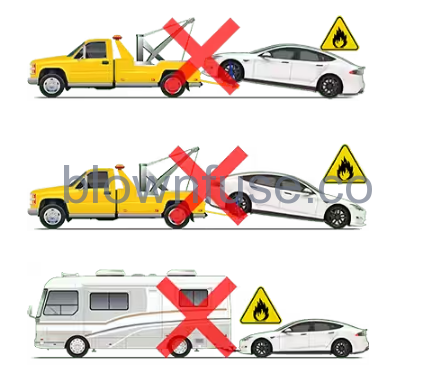
Do not transport Model S using any method that is not specified by Tesla. Adhere to the instructions provided in the following sections and observe all warnings and cautions provided. Damage caused by improper transporting of your vehicle is not covered by the warranty.
Approved Methods for Transporting
A flatbed truck or comparable transport vehicle is the recommended method of transporting Model S. The vehicle can face either direction when using a flatbed.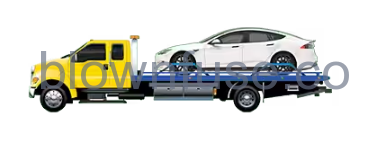
If Model S must be transported without a flatbed truck, then wheel lifts and dollies must be used to ensure that all four wheels are off of the ground. This method may only be used for a maximum of 35 miles (55 km), and must not exceed the manufacturer speed rating of the dollies. With this method, Tesla recommends the vehicle faces forward so that the front wheels are lifted and the rear wheels are on dollies.

Disable the Self-Leveling Air Suspension System
Your Model S is equipped with an air suspension system that automatically self-levels the vehicle, even when power is off. To prevent damage, you must activate Jack mode to disable self-leveling:
- Touch on the touchscreen.
- Press the brake pedal, and then touch Very High to maximize height.
- Touch .
Activate Transport Mode
Transport Mode keeps the parking brake disengaged while winching Model S onto a flatbed truck. When active, Transport Mode displays a message indicating that the vehicle will remain free-rolling. The following are required to enable Transport Mode:
- Low voltage power. You are unable to use the touchscreen to activate Transport Mode if Model S has no power.
- Model S must detect a key. Transport Mode is available only when a key is detected.
To activate Transport Mode:
- Ensure the vehicle is in Park.
- Check the tires and make sure Model S is secure.
- Press and hold the brake pedal, and then on the touchscreen, touch . The touchscreen displays a message reminding you how to properly transport Model S.
- Press and hold the Transport Mode button until it turns blue. Model S is now free-rolling and can slowly be rolled (no faster than walking speed) for short distances or winched.
To cancel Transport Mode, shift Model S into Park.
Pull Onto Flatbed Truck From Front (Using Tow Eye)
- Locate the tow eye. The tow eye is located in the front trunk.
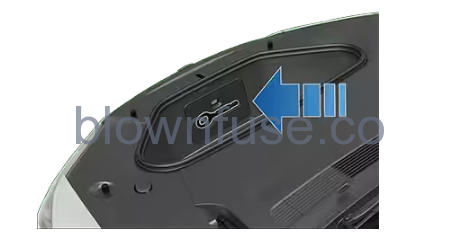
- Release the front tow eye cover by pressing firmly on its top right perimeter until it pivots inward, then gently pulling the raised section toward you.
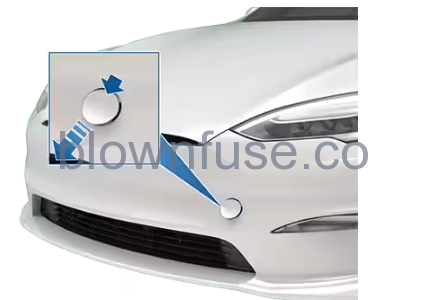 NoteThe front tow eye cover is connected to the vehicle’s black negative (-) terminal.
NoteThe front tow eye cover is connected to the vehicle’s black negative (-) terminal. - Fully insert the tow eye into the opening, then turn it counter-clockwise until securely fastened.
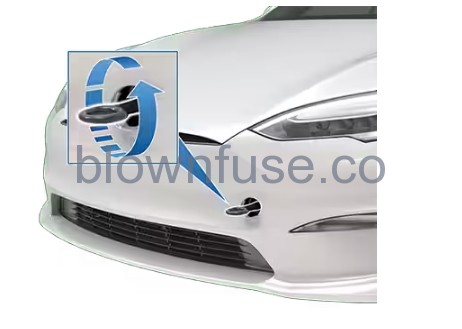
- Attach the winch cable to the tow eye.
CAUTIONBefore pulling, make sure the tow eye is securely tightened.
- Activate Transport Mode.
- Pull Model S slowly onto the flatbed truck.
Pull Onto Flatbed Truck From Rear (Using Tow Eye)
- Locate the tow eye. The tow eye is located in the front trunk.
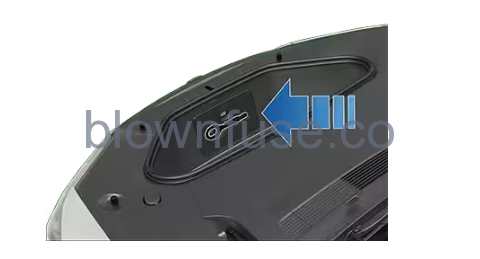
- Release the rear tow eye cover by pressing firmly on its bottom perimeter until it pivots inward, then gently pulling the raised section toward you.
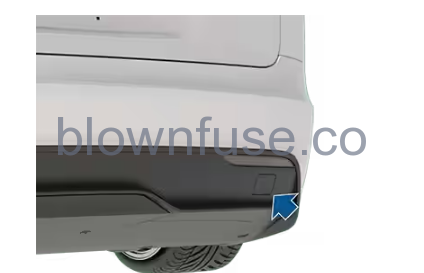
- Fully insert the tow eye into the opening, then turn it counter-clockwise until securely fastened.
- Attach the winch cable to the tow eye.
CAUTIONBefore pulling, make sure the tow eye is securely tightened.
- Activate Transport Mode.
- Pull Model S slowly onto the flatbed truck.
Pull onto the Flatbed Truck From Front (Without Tow Eye)
It is strongly recommended that you connect the winch to your vehicle’s tow eye, as described previously. However, if a situation arises in which the tow eye is not available (lost, misplaced, etc.), the following instructions describe how to attach tow straps.
- Attach the tow straps to each of the lower suspension arms underneath the front of the vehicle.
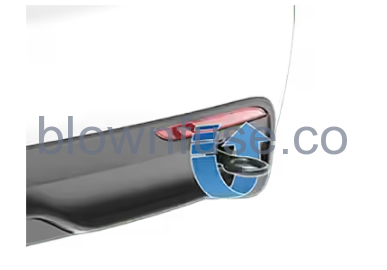
- To protect the underbody from damage, place a protective barrier (such as a piece of wood) between the tow strap and underbody.
- Activate Transport Mode.
- Pull Model S slowly onto the flatbed truck.
Secure the Tires
The vehicle’s tires must be secured onto the truck using the eight-point tie-down method.
- Ensure any metal parts on the tie-down straps do not contact painted surfaces or the face of the wheels.
- Do not place tie-down straps over body panels or through the wheels.
If Vehicle Has No Power
If Model S has no low voltage power, perform the following steps to open the hood or jump start the auxiliary low voltage battery.
Jump-Starting the Low Voltage Battery
- Open the hood (see Opening Hood with No Power).
- Remove the maintenance panel by pulling it upwards to release the trim clips that hold it in place.
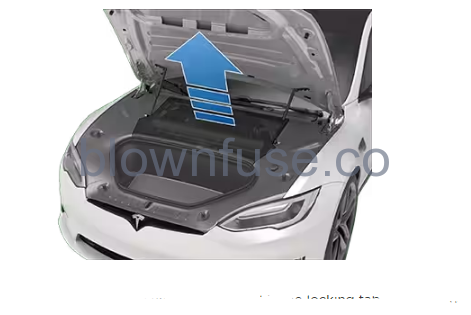
- On top of the low voltage battery, lift the locking tab that attaches the electrical connector to the connector housing.
NoteThe appearance of the electrical connector and connector housing may vary, but the procedure remains the same.
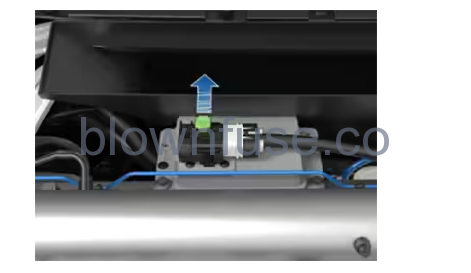
- On top of the low voltage battery, pull the connector housing to the left. The electrical connector released from the low voltage battery.
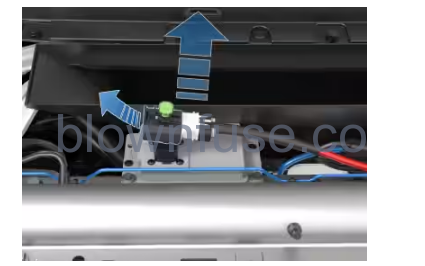
- Release the cover from the red positive (+) jump post, and then connect the low voltage power supply’s red positive (+) cable to the red positive (+) jump post.
CAUTIONTo avoid damaging Model S, do not allow the positive cable to contact other metal components.
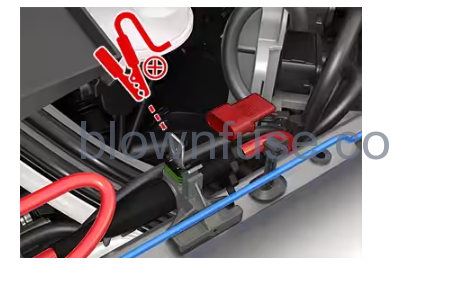
- Connect the low voltage power supply’s black negative (-) cable to the vehicle in the location shown.
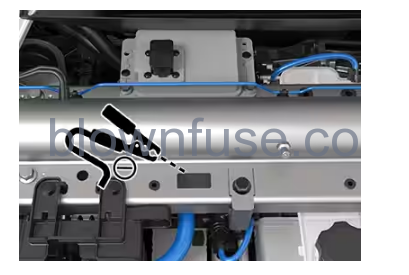
- Turn on the external power supply (refer to the manufacturer’s instructions). Touch the touchscreen to wake it up.
NoteIt may take several minutes to receive enough power to wake up the touchscreen.
- When external low voltage power is no longer required, disconnect both cables, beginning with the black negative (-) cable.
- On top of the low voltage battery, push the connector housing towards the electrical connector so that the electrical connector engages the low voltage battery.
- On top of the low voltage battery, push down the locking tab that attaches the electrical connector to the connector housing.
- Replace the maintenance panel by placing it back in its original location and pressing it down until it is secure.
- Close the hood.

